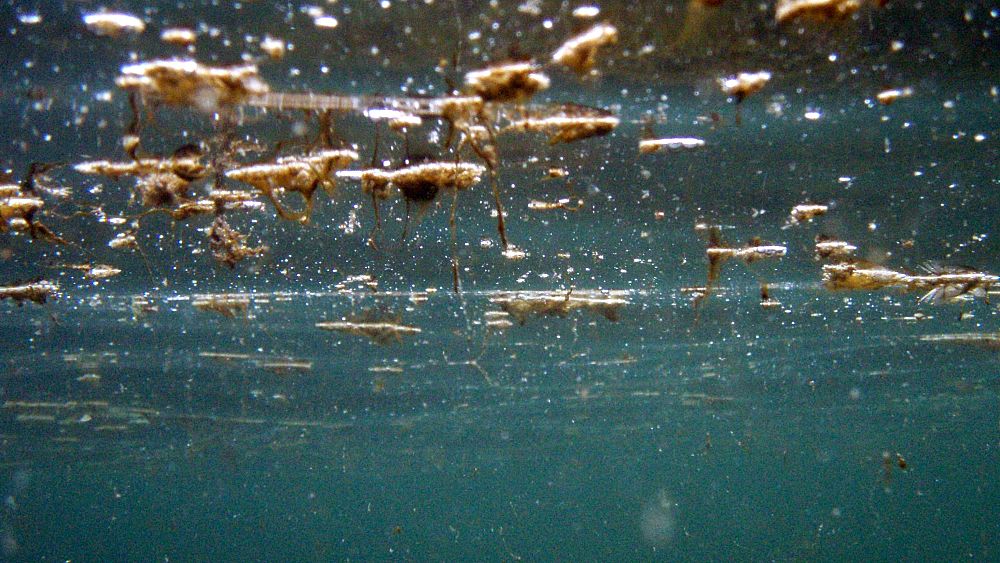
Since 2021, a toxic variant of an algae named ‘ostreopsis’ has become increasingly prevalent in the Atlantic Ocean.
A new report by ANSES, the French National Health Security Agency, warns of the dangers of human contact with the algae and its toxins.
Marc Rappoport, a doctor who lives in Biarritz believes he was contaminated when surfing in Saint-Jean-de-Luz, in the Basque region.
“I started getting symptoms 45 minutes after entering the water. I had nausea but continued to surf,” he tells Euronews Green. “In the afternoon I started feeling achey, my eyes were red and I was extremely tired. It lasted 48 hours and my symptoms were similar to the flu.”
Whilst inhaling sea spray remains the most common mode of infection, it can also occur through skin contact and ingestion. Symptoms typically surface within hours of direct or indirect contact with the algae and tend to disappear within a matter of days.
As well as surfers, those who work on beaches – such as lifeguards – are at particular risk of infection. When contacted by Euronews Green, the Basque Committee of Lifeguards stated that they had not yet charted a significant rise in cases of ostreopsis among personnel.
Workers in nearby shops and restaurants also risk airborne exposure, according to the report. “People with respiratory problems” should also be especially vigilant, according to to ANSES spokesperson Carole Castini.
Monitoring algae levels in France and Spain’s coastlines
In 2021, multiple beaches in Biarritz, Saint-Jean-de-Luz and Bidart, in the Basque coast were closed off as a preventive measure due to high levels of ostreopsis.
However, monitoring ostreopsis infections proved difficult for health authorities during the pandemic. Symptoms were similar to COVID-19, but authorities have since intensified scientific monitoring of the region’s waters.
Maïder Arosteguy, Mayor of Biarritz – a city which attracts thousands of tourists every year – told Euronews Green that closing beaches remains highly unlikely this year.
“We have more information now than we did in 2021. We also know that if we closed off beaches, we should also close off nearby restaurants and shops because of its presence in the air.”
“We were very disappointed with the French National Health Security Agency for not sending us the report before it was publicly released. We must now rush to action but were not warned before of the findings.”
Arosteguy added that when ostreopsis levels reach alarming rates they will be catalogued in Kalilo, a weather app which operates in the Basque region.
However, some organisations feel that monitoring by authorities could go further. NGO Surf Rider Europe – which works to preserve ocean’s across Europe – has been regularly sampling ostreopsis levels in surfing zones.
“Surfers travel from around the world to surf here, but they don’t necessarily listen to warnings about algae but we want to ensure their safety”, Marc Valmassoni, Surf Rider Europe spokesperson told Euronews.
Surfers risk particularly high levels of contamination “swimmers will go into the water for 10 to 15 minutes at a time, but a surfer will be in there significantly longer. A surfer will drink on average drink the equivalent of 1 cup of water per surf session.”
The NGO has been raising awareness about the dangers of the algae in local surf clubs, as well as in pharmacies and in community hubs.
Is climate change bringing toxic algae to Europe’s coastlines?
Ostreopsis outbreaks mainly occur in summertime, when water temperatures exceed 20 degrees.
The microalgae were first observed in France in 1972, and are now regularly found along the Mediterranean coastlines of France, Italy and Spain.
The toxic variant of ostreopsis is named the ‘ovata’ strain and originates from tropical waters. Due to a combination of global warming and maritime transport movements, it surfaced in the Mediterranean.
Ostreopsis has a brown-reddish colour but is not usually visible due to its microscopic size. But it can aggregate into floating blooms, as well as give water a metallic taste. Nevertheless, other forms of algae can also merge into blooms in the Atlantic Ocean and be mistaken for ostreopsis.